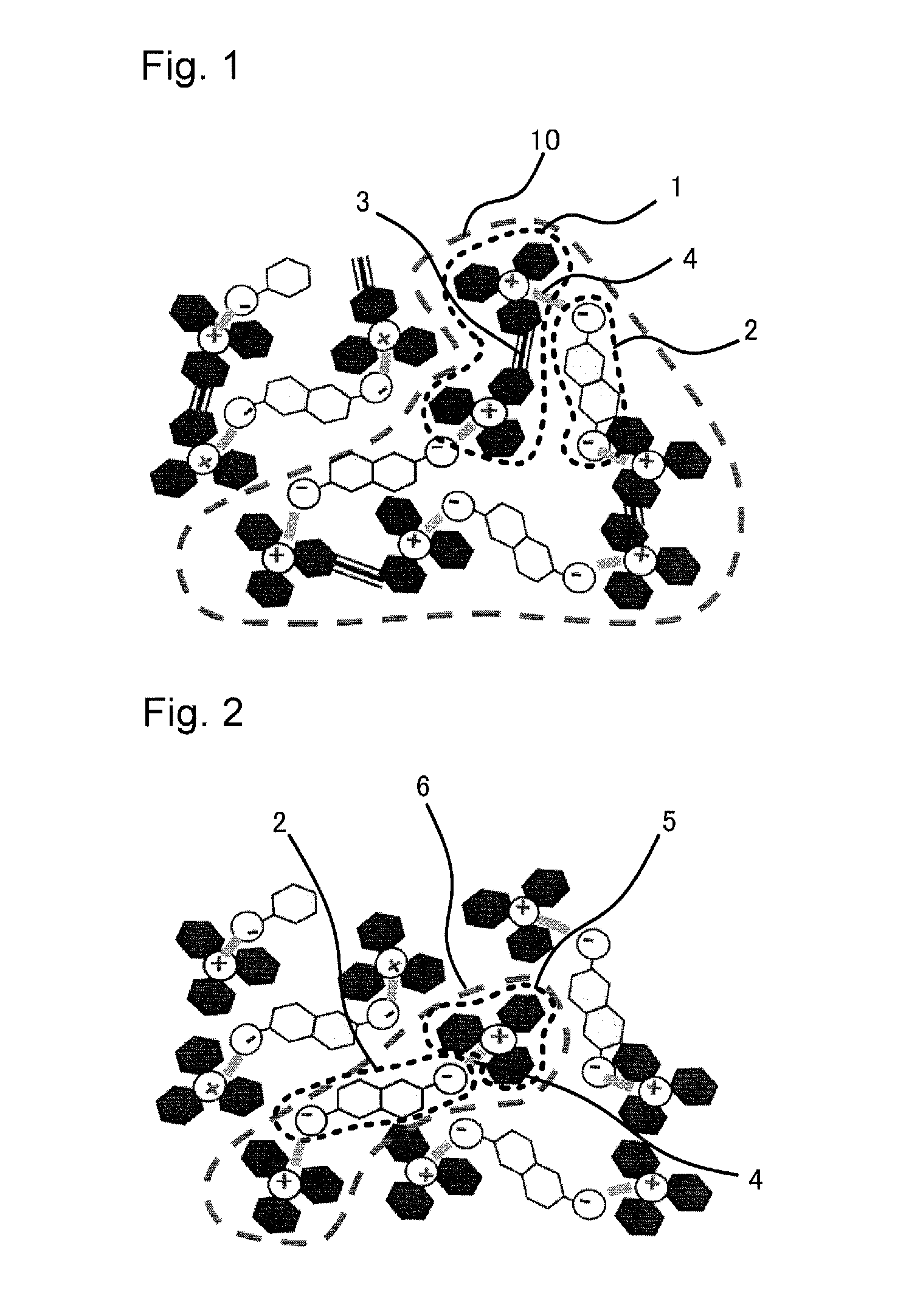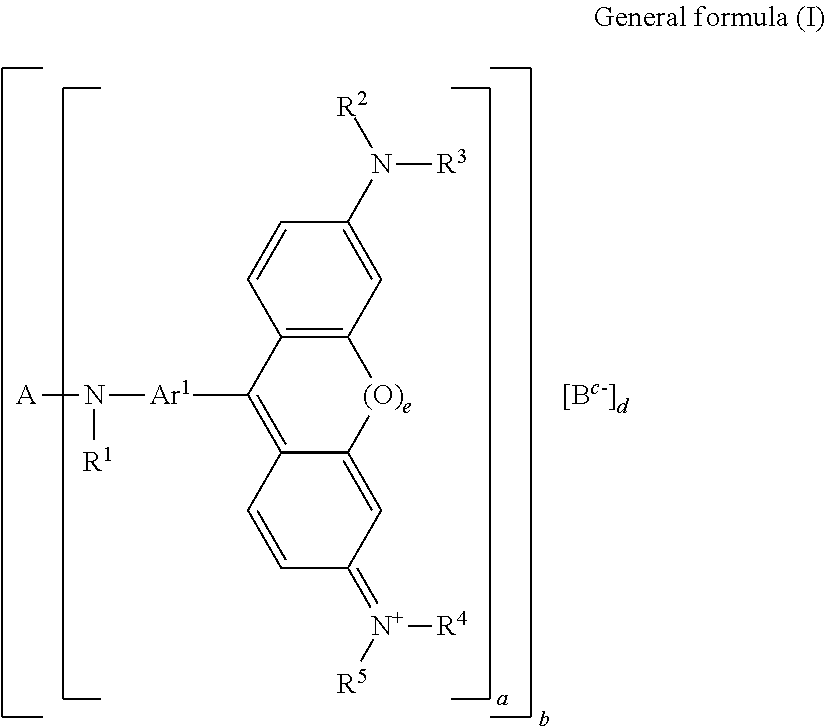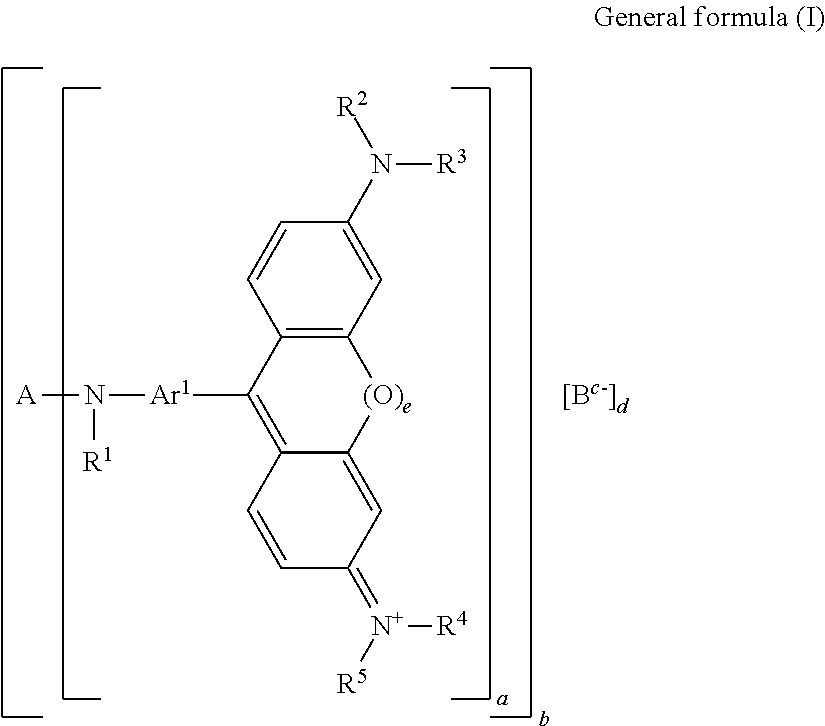Color material and method for producing the same
a color material and dye technology, applied in the field of new color materials, can solve the problems of insufficient heat resistance of compounds, insufficient yield of polysiloxane dye, and insufficient heat resistance of salt-forming compounds containing dyes and counter anion disclosed in patent literatures to 3 , to achieve excellent heat resistance, high yield, and high purity
- Summary
- Abstract
- Description
- Claims
- Application Information
AI Technical Summary
Benefits of technology
Problems solved by technology
Method used
Image
Examples
examples
[0126]Hereinafter, the present invention will be explained in detail, with reference to examples. The scope of the present invention is not restricted by these examples, however.
Synthesis Example
Synthesis of Intermediate 1
[0127]First, 18.7 g (73.4 mmol) of 1-iodonaphthalene, 9.88 g (102.8 mmol) of sodium tert-butoxide (both manufactured by: Wako Pure Chemical Industries, Ltd.), 5.0 g (36.7 mmol) of p-xylenediamine (manufactured by: Tokyo Chemical Industry Co., Ltd.), 0.27 g (0.57 mmol) of 2-dicyclohexylphosphino-2′,4′,6′-triisopropylbiphenyl (manufactured by: Aldrich) and 0.054 g (0.28 mmol) of palladium acetate (manufactured by: Wako Pure Chemical Industries, Ltd.) were dispersed in 36 mL of xylene and reacted at 130 to 135° C. for 24 hours. After the reaction, the resultant was cooled to room temperature. Crystals thus precipitated were filtered and then washed with methanol. Next, the crystals were washed with water and dried to obtain 9.79 g (yield 69%) of intermediate 1 represe...
example 1
Synthesis of Color Material A
[0135]First, 1.03 g (3.10 mmol) of disodium 2,6-naphthalenedisulfonate (manufactured by: Tokyo Chemical Industry Co., Ltd.), 30 mL of methanol and 20 mL of water were mixed and agitated at 50 to 55° C. Next, 3.33 g (3.10 mmol) of intermediate 2 was added to the mixture, and the mixture was stirred at 50 to 55° C. for hour. The solution was concentrated by means of an evaporator to evaporate the methanol, and 100 mL of water was added thereto. The mixture was filtered to obtain a precipitate, and the precipitate was washed with water. The thus-obtained cake was dried to obtain 3.37 g (yield 84%) of color material A represented by the following chemical formula (3).
[0136]From the following analysis result, the obtained compound was confirmed to be a desired compound.
[0137](ESI) (m / z): 502(+), divalent, 143(−), divalent
[0138]Values of elemental analysis: CHN actual measurement values (74.68%, 6.63%, 6.21%); theoretical values (74.50%, 6.56%, 6.52%)
example 2
Synthesis of Color Material B
[0139]First, 0.92 g (2.12 mmol) of trisodium 1,3,6-Naphthalenetrisulfonate (manufactured by: Tokyo Chemical Industry Co., Ltd.), 40 mL of methanol and 20 mL of water were mixed and agitated at 50 to 55° C. Next, 3.44 g (3.20 mmol) of intermediate 2 was added thereto, and the mixture was agitated at 50 to 55° C. for hour. The solution was concentrated by means of an evaporator to evaporate the methanol, and 100 mL of water was added thereto. The mixture was filtered to obtain a precipitate, and the precipitate was washed with water. The thus-obtained cake was dried to obtain 3.12 g (yield 78%) of color material B represented by the following chemical formula (4).
[0140]From the following analysis result, the obtained compound was confirmed to be a desired compound.
[0141]MS (ESI) (m / z): 502(+), divalent, 121(−), trivalent
[0142]Values of elemental analysis: CHN actual measurement values (73.97%, 6.62%, 6.91%); theoretical values (73.84%, 6.57%, 6.74%)
Synthes...
PUM
| Property | Measurement | Unit |
|---|---|---|
| Temperature | aaaaa | aaaaa |
| Color | aaaaa | aaaaa |
| Solubility (mass) | aaaaa | aaaaa |
Abstract
Description
Claims
Application Information
 Login to View More
Login to View More - R&D
- Intellectual Property
- Life Sciences
- Materials
- Tech Scout
- Unparalleled Data Quality
- Higher Quality Content
- 60% Fewer Hallucinations
Browse by: Latest US Patents, China's latest patents, Technical Efficacy Thesaurus, Application Domain, Technology Topic, Popular Technical Reports.
© 2025 PatSnap. All rights reserved.Legal|Privacy policy|Modern Slavery Act Transparency Statement|Sitemap|About US| Contact US: help@patsnap.com



